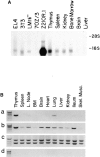Molecular cloning and biological characterization of a novel murine lymphoid growth factor
- PMID: 10974033
- PMCID: PMC2193273
- DOI: 10.1084/jem.192.5.671
Molecular cloning and biological characterization of a novel murine lymphoid growth factor
Abstract
Using a bioassay consisting of the proliferation of a murine B cell line, a cDNA of a gene whose product supports the growth of that cell line was isolated from a thymic stromal cell line. This factor, termed thymic stromal lymphopoietin (TSLP), is a protein of 140 amino acids. The gene encoding TSLP was mapped to murine chromosome 18. Purified recombinant TSLP supported the growth of pre-B cell colonies in vitro, but had no myelopoietic activity. TSLP had comitogenic activity for fetal thymocytes, but was not as potent as interleukin 7 in lobe submersion cultures. Injection of TSLP into neonatal mice induced the expansion of B220(+)BP-1(+) pre-B cells.
Figures






References
-
- Cumano A., Kee B.L., Ramsden D.A., Marshall A., Paige C.J., Wu G.E. Development of B lymphocytes from lymphoid committed and uncommitted progenitors. Immunol. Rev. 1994;137:5–33. - PubMed
-
- Billips L.G., Petitte D., Dorshkind K., Narayanan R., Chiu C.-P., Landreth K.S. Differential roles of stromal cells, interleukin-7, and kit-ligand in the regulation of B lymphopoiesis. Blood. 1992;79:1185–1192. - PubMed
-
- Nagamine J., Takeda K., Tatsumi Y., Ogata M., Miyake K., Hamaoka T., Fujiwara H. Role of a thymic stromal cell clone in inducing the stage-specific differentiation of various subpopulations of double negative thymocytes. J. Immunol. 1991;147:1147–1152. - PubMed
-
- Williams D.E., Eisenman J., Baird A., Rauch C., Van Ness K., March C.J., Park L.S., Martin U., Mochizuki D.Y., Boswell H.S. Identification of a ligand for the c-kit proto-oncogene. Cell. 1990;63:167–174. - PubMed
Publication types
MeSH terms
Substances
Grants and funding
LinkOut - more resources
Full Text Sources
Other Literature Sources
Molecular Biology Databases
Research Materials

